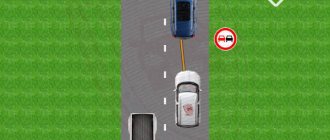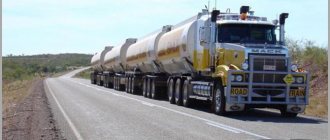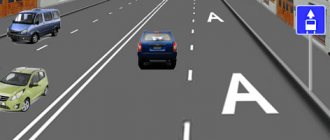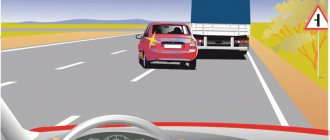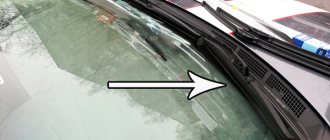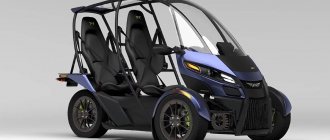Mopeds, motorbikes, mokikis
Vehicles equipped with two wheels, the maximum permissible speed of which cannot be higher than 50 km/h, belong to category L1. These vehicles may differ in technical characteristics, expressed in the following parameters:
- if there is an internal combustion engine, its total internal volume should not exceed 50 cm3;
- If there is an electric motor, the maximum power in continuous load modes should not exceed 4 kW.
Vehicles equipped with three wheels and with a permitted maximum speed of 50 km/h. belong to the L2 category. The following restrictive characteristics are established for such vehicles:
- if an internal combustion engine is installed, its volume should not be more than 50 cm3;
- if an electric motor is installed, its maximum power should not exceed 4 kW;
- ICEs of other types are also limited to a power parameter of 4 kW.
In the case of three-wheeled vehicles, their location on the frame of the device does not matter.
We are on Twitter:
Login Registration
Automotive news
Rules for the movement of heavy trucks in the automatic weight control zone have been adopted. The Federal Tax Service has approved the application form for the death or destruction of a vehicle. In Russia, it is forbidden to disembark children without a ticket from buses. A new sign 6.22 has been introduced in the traffic rules - “photo and video recording” Testing for alcohol dependence has been postponed for another year. The Ministry of Health has updated the requirements for completing car first-aid kits, the Ministry of Transport has approved the procedure and terms for storing diagnostic maintenance cards. Obtaining permission for international transport will now be done in a new way. You can now check your MTPL policy for authenticity online. The Central Bank has set new tariffs for MTPL.
/ Legal articles on the topic of automobile law / Miscellaneous / Vehicles of category M1
Vehicles of category M1
The Technical Regulations of the Customs Union on the safety of wheeled vehicles is a document that reflects all the requirements that are planned to be imposed on vehicles. Category M-1 in this act is one of the largest groups of vehicles.
Basic provisions
A feature of the new regulations is the division of vehicles into special categories that ordinary motorists have not encountered before. In total the following varieties are found:
- L1-L2. They include two-wheeled vehicles with engines up to 50cc. Attention is also paid to the maximum speed of such equipment: it should not exceed 50 km/h. If an electric motor is installed, its maximum power can be up to 4 kW.
- L3-L5 – motorcycles and tricycles. The category is designed for two- and three-wheeled vehicles with an engine capacity above 50 cc. cm, and the speed exceeds 50 km/h. Essentially, these are all motorcycles and other equipment that in a simple UL belong to category A.
- L6-L7 – ATVs. This is a four-wheeled vehicle, the mass of which is not higher than 350 kg, the speed is not higher than 50 km/h, if an internal combustion engine is installed, its volume should not exceed 50 cubic meters. see. For an electric motor, the power limit is 4 kW. This also includes similar vehicles weighing 400-550 kg, if the latter are designed to transport goods. The power of the gasoline engine is not limited, the electric motor is up to 15 kW.
- M1 is the largest category and denotes passenger cars.
- M2-M3 – vehicles for transporting passengers, including trolleybuses.
- N1 – it includes vehicles for cargo transportation that do not have additional passenger seats; the weight of vehicles in this category should not exceed 3500 kg.
- N2 – this includes trucks weighing more than 3.5 tons, but not exceeding 12 tons
- N3 – any trucks whose weight exceeds 12 tons.
- O1-O4 – trailers for vehicles. The main criterion for classifying these subcategories is the difference in the weight of trailers and their maximum carrying capacity.
This article will focus only on passenger cars, since they are the most common type of equipment about which questions are most often asked. The Customs Union includes passenger cars with up to 8 passenger seats in the M1 category. If we compare it with a regular driver’s license, these are all cars belonging to category B.
Category B gives the right to drive any vehicle weighing less than 3500 kg. There cannot be more than eight passenger seats; it is permissible to use a trailer with a load capacity of up to 750 kg. Such vehicles include cars, SUVs, minibuses, and light trucks. Category M-1 will include those requirements of technical regulations that are of interest to car owners. At the same time, if you have a vehicle that belongs to category B, but is a cargo vehicle, the Customs Union does not classify it as M-1 and uses another group for identification - M-2.
What is included in the M-2 category?
This group is a fairly broad category that includes all passenger modes of transport. It does not coincide with the categories allocated for them in the VU. This includes vehicles weighing up to 5 tons; the permitted number of passenger seats must be more than eight. For equipment weighing more than 5 tons, there is its own category - M-3.
It is worth noting that buses and trolleybuses can be classified as either M-2 or M-3 depending on their weight. When compared with a regular driver's license, M-2 and M-3 will correspond to categories C and D depending on the type of vehicle and its weight. The traffic police uses other rules that regulate the technical inspection process, namely the Requirements for vehicles in operation. That is why, when clearing equipment through customs, representatives of the road inspection will be interested in the first act, and when registering – in the second.
Time frame for investigating a criminal case of an accident
Rules for transporting goods on a passenger trailer
vehicle categories
86990
No comments yet. Yours will be the first!
Write a comment
New comments
Badyrgy → Removal and expungement of a criminal record under Art. 264.1 of the Criminal Code of the Russian Federation 3 days ago
Convicted in 2014 of Part 1 of Article 264 of the Criminal Code of the Russian Federation with restriction of freedom and deprivation of rights for 1 year. How to expunge a criminal record? And where to go
Vladimir → Is it necessary to give way to a bus leaving the bus stop... 18 days ago
The rules state that the driver must give way to a bus departing from a stop within the city limits, but I drive at a speed of 60 km per hour at the main speed...
Automotive Lawyer → Deprivation of the right to drive under Art. 264 of the Criminal Code of the Russian Federation. About the most... 1 month ago
Hello. The period of criminal punishment in the form of deprivation of the right to drive runs, regardless of whether the vehicle is passed or not. The traffic police have been punished for enforcing this...
Evgeniy → Deprivation of the right to drive under Art. 264 of the Criminal Code of the Russian Federation. About the most... 1 month ago
Good evening! In 2014, he was convicted under Part 264 of the Criminal Code and served a real sentence of 2 years in a penal colony; the court also deprived him of his license for 3 years, after...
Automotive Lawyer → Deprivation of the right to drive under Art. 264 of the Criminal Code of the Russian Federation. About the most... 1 month ago
Hello. The terms of deprivation under the article of the Code of Administrative Offenses of the Russian Federation and under the article of the Criminal Code of the Russian Federation are not cumulative. Each term is calculated independently, i.e., independently of each other
Motorcycles, scooters, tricycles
The traffic rules also provide for other subcategories for vehicles with limited characteristics:
- L3 - vehicles equipped with two wheels, the volume of the internal combustion engine of which should not be higher than 50 cm3. The maximum speed allowed by their design characteristics is 50 km/h;
- L4 – mechanisms for movement, equipped with three wheels, which are located asymmetrically with respect to the longitudinal line of the vehicle. The working volume of their internal combustion engines is no more than 50 cm3. Structurally permissible maximum speed is 50 km/h;
- L5 – category having characteristics identical to L4;
The main difference between these categories is the distance between the points of contact of the wheels with the road surface. If this value does not exceed 46 cm, the vehicle belongs to category L3.
To drive vehicles of subcategories L3-L5, you must obtain a driver's license with open category A.
ATVs
ATVs are vehicles belonging to subcategory L6. Their maximum weight, without additional cargo, should not exceed 350 kg. The weight of the batteries is not taken into account if the vehicle is powered by an electric motor. For such units, the maximum permissible speed is 50 km/h.
Subcategory L7 has similar parameters, with the exception of the maximum unladen weight. This value should not exceed 400 kg. for ordinary vehicles and 550 for trucks.
To operate an ATV of subcategory L6, you must open category M. For those ATVs that have increased power parameters, you will need to open category B1.
Category O
Category O - Trailers (semi-trailers) for vehicles of categories L, M, N, including: (Note by ASMAP).
Category O1 - Trailers whose technically permissible maximum weight is not more than 0.75 tons.
Category O2 - Trailers with a technically permissible maximum weight of more than 0.75 tons, but not more than 3.5 tons.
Category O3 - Trailers with a technically permissible maximum weight of more than 3.5 tons, but not more than 10 tons.
Category O4 - Trailers with a technically permissible maximum weight of more than 10 tons.
A vehicle with no more than eight seats, excluding the driver's seat, intended for the carriage of passengers and goods, belongs to the category:
- M1, if the product of the number of passengers provided for by the design by the conditional mass of one passenger (68 kg) exceeds the estimated mass of cargo transported simultaneously with passengers;
- N if this condition is not met.
A vehicle designed for the transport of passengers and goods, having, in addition to the driver's seat, more than eight seats, belongs to category M.
In short, then
- M1 - vehicles used for the transport of passengers and having, in addition to the driver’s seat, no more than eight seats;
- M2 - vehicles used for the transport of passengers, having, in addition to the driver’s seat, more than 8 seats, the technically permissible maximum weight of which does not exceed 5 tons;
- M3 - vehicles used for the transport of passengers, having, in addition to the driver’s seat, more than 8 seats, the technically permissible maximum weight of which exceeds 5 tons;
- N1 - vehicles for the transportation of goods, having a technically permissible maximum weight of no more than 3.5 tons;
- N2 - vehicles intended for the transportation of goods, having a technically permissible maximum weight of over 3.5 tons, but not more than 12 tons;
- N3 - vehicles intended for the transportation of goods, having a technically permissible maximum weight of more than 12 tons;
- O1, O2 - trailers, the technically permissible maximum weight of which is not more than 3.5 tons;
- O3, O4 - trailers, the technically permissible maximum weight of which is over 3.5 tons;
- L - motor vehicles.
Source
How to open a new category of rights
Transport categories open up the possibility of undergoing specialized training at a driving school. The opening of a category for a more complex vehicle is accompanied by passing a full examination. If it is necessary to open subcategories within a category, some exams may be canceled because the applicant has already passed them when receiving a licence.
The complex of examination activities includes testing of theoretical knowledge and practical skills. To open an additional category, you need to submit a request to the driving school and receive information about the requirements that apply in this case.
Category M - Passenger vehicles
Cars
Category M1 - Vehicles used for the transport of passengers and having, in addition to the driver's seat, no more than eight seats.
Buses, trolleybuses, specialized passenger vehicles
Category M2 - Vehicles used for the transport of passengers, having, in addition to the driver's seat, more than eight seats, the technically permissible maximum weight of which does not exceed 5 tons.
Category M3 - Vehicles used for the transport of passengers, having, in addition to the driver's seat, more than eight seats, the technically permissible maximum weight of which exceeds 5 tons.
Category O - Trailers
Category O1 - Trailers with a technically permissible maximum weight of no more than 0.75 tons.
Category O2 - Trailers with a technically permissible maximum weight of more than 0.75 tons, but not more than 3.5 tons.
Category O3 - Trailers with a technically permissible maximum weight of more than 3.5 tons, but not more than 10 tons.
Category O4 - Trailers with a technically permissible maximum weight of more than 10 tons.

